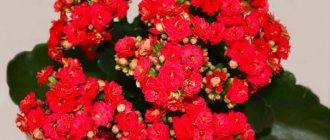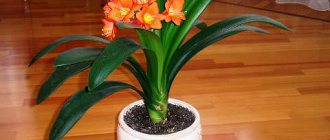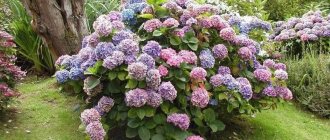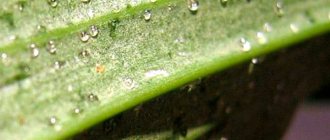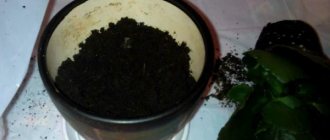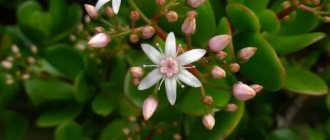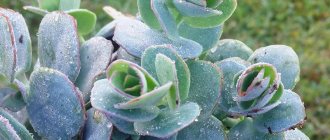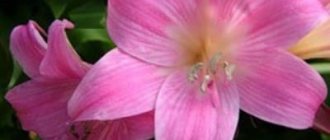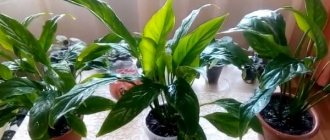Decorative flowering Kalanchoe is a very unpretentious indoor plant. Caring for it is not difficult. A bush purchased in a store pleases with abundant flowering for a long time.
However, it is not always possible for inexperienced gardeners to achieve re-blooming at home. Very often the leaves of the plant become smaller and the buds do not appear. Don’t rush to throw away your Kalanchoe: following basic rules of caring for it will help ensure the appearance of flowers.
Incorrect lighting and long daylight hours
Kalanchoe needs bright sunlight. In this case, the daylight hours for this plant should be no more than 8-9 hours. Therefore, in the middle zone it is almost impossible to achieve flowering in natural light.
In the summer, when there are many sunny days, daylight reaches 15-16 hours, but in winter, when it approaches normal, there is almost no sun.
If the Kalanchoe does not bloom and stretches out, you need to do the following:
- Keep the flower on a bright eastern windowsill so that it is exposed to the sun's rays in the morning;
- Limit daylight hours to 8-9 hours;
- In winter, when there is little sun, you can use artificial lighting lamps;
- If the plant does stretch out in winter, it is necessary to regularly carry out formative pruning of the bush, shortening its shoots to 10 cm.
Kalanchoe has stopped blooming, but is not stretching
Sometimes a culture not only refuses to produce new buds, but also stops growing:
- When transplanting into a pot that is too large, when the root cannot quickly absorb the entire volume of the new substrate.
- The owners constantly pinch the tops of the shoots briefly, trying to achieve the ideal shape of the bush. Kalanchoe can devote all its energy to growing new branches and not put forward flower stalks. At some point you have to stop.
- The temperature is above 38° C. Naturally, the bush will not bloom. But it won’t stretch, growth will simply stop.
- Pests or diseases depress the plant as a whole, and not just prevent it from blooming.
- Constant drafts can be a negative factor for the protrusion of buds and the development of the bush. Or if the owners put the pot directly under the stream of a working air conditioner, it makes no difference whether it blows warm or cold air.
Too frequent and abundant feeding or lack thereof
A mandatory procedure for caring for Kalanchoe is feeding it with fertilizers.
But here it is important not to overfeed him. The plant reacts very poorly to excess nutrients and minerals in the soil. If it is fed too often, it may stop blooming or drop the buds it has formed.
Feed the flower from May to early October 1-2 times a month. In this case, you need to use fertilizers not for flowering plants, but for succulents . The concentration when diluting the fertilizer in water should be 2 times lower than indicated on the package. In the autumn-winter period, the plant is not fed.
If Kalanchoe grows in very poor, nutrient-deprived soil, it will bloom reluctantly even with the right lighting. Its leaves become smaller, Kalanchoe grows upward and does not bloom. Therefore, for annual and abundant flowering, you cannot completely abandon the application of fertilizers.
Basic rules of care
Kalanchoe can look very different: among them there are both neat miniature bushes and vines with long weaving shoots. Despite their very different appearance, home care rules for all succulents are approximately the same. The main thing is to create a habitat that is as close to natural as possible.
Lighting
In the wild, most varieties of Kalanchoe live in open spaces well illuminated by sunlight. Therefore, indoor plants should be kept in bright light. However, given that their foliage tends to take on reddish hues from excess light, it is better for the light to be somewhat diffused.
Sun
The succulent is also able to survive in the shade, but at the same time it stretches out strongly in search of the life-giving sun. The upper leaves lose their brightness and turn pale, the lower leaves crumble. In this case, flowering may not happen at all. When placing Kalanchoe, you must follow the recommendations of experienced gardeners:
- In spring and summer, place the flower on windowsills oriented to the southwest or southeast.
- In autumn, it is better to move the plant pot to a south window until spring. If necessary, on rainy and gloomy days, organize additional illumination using fluorescent or phytolamps.
Temperature
Kalanchoe, like other succulents, develops best at moderate air temperatures. But, in principle, a flowering plant is not particularly demanding on temperature indicators; a run-up from +13 to +28 °C is optimal for it. Ideally, the mode is like this:
- In winter - +13...+16 °С. Short-term cold snaps up to +8 °C are acceptable. But if the cool condition is too long, the plant may get sick and even die.
- In summer - +23...+28 °С. But the succulent also tolerates heat well, although due to dryness it sometimes drops its leaves.
Room thermometer
Early in the spring, as soon as the street air warms up to at least +10 °C, it would be good to take the Kalanchoe for a “walk” on the loggia, balcony or terrace. Let it stay there until the fall, until it gets colder again. Some gardeners plant the flower in open ground for the summer, and then take it back into the house with the arrival of autumn cold weather.
Watering mode
Like all succulent crops, flowering Kalanchoe stores moisture in its thick and fleshy leaves. There is no need to water it too often. The signal for the next moistening will be the drying of the top soil layer in the pot. General recommendations for the frequency of watering are as follows:
- in summer - 2-3 times a week;
- in winter - once a week and a half.
Watering
You need to use only well-settled (at least 24 hours), filtered, rain or melted, soft water, with a temperature approximately equal to the ambient temperature. Too cold watering liquid, as well as constant dampness in the planting container, are dangerous due to rotting of the roots.
It is important to water the soil around the trunk in the pot, using a watering can with a narrow spout.
Humidity
Kalanchoe is absolutely indifferent to air humidity; it is quite satisfied with average values in the region of 45-60%. But it tolerates both short periods of excess moisture and dryness equally well. The leaf blades are sometimes covered with short fluff, in which case fluctuations in humidity are definitely not scary for the plant.
Blooming Kalanchoe
This succulent does not need additional spraying; it feels great in normal indoor conditions. It is enough to wipe dusty foliage with a damp cloth. Only at the very peak of the summer heat can it be slightly moistened with a fine spray bottle. In winter, “water procedures” are strictly contraindicated, because in damp conditions a green pet can get sick.
Priming
In their natural environment, succulents grow in poor soils, so they don’t need special treatments. You can purchase specialized soil marked “For cacti and succulents” or prepare it yourself from the following components:
- garden or garden soil - 4 parts;
- coarse sand - 1 part;
- lowland peat - 1 part;
- a little charcoal (for disinfection) and perlite.
Organic additives, such as humus or compost, are usually not added.
Preparing soil for a Kalanchoe flower
You can use any universal store-bought substrate, but you will need to add sand (a quarter of the volume) to it. The main thing is that the soil mixture for Kalanchoe is light and loose, has good air permeability and does not retain too much moisture.
Feeding
Kalanchoe is not a very fast-growing crop; it consumes nutrients sparingly, so it does not need frequent feeding. During the growing season - spring and summer, the plant is fed very modestly - with fertilizers for cacti and succulents, taken in half the volume specified in the instructions for the product and no more than once every 3-4 weeks.
Nourished Kalanchoe Blossfeld
Moreover, they should be applied exclusively in liquid form, having previously been dissolved in water.
In winter, during the dormant period, any fertilizing should be abandoned, because the sleeping flower will still not be able to absorb the added nutrients. An excess of fertilizers for succulent crops is extremely dangerous, so you need to use different nutritional compositions carefully.
Trimming
An important condition for proper care of Kalanchoe is crown formation and pruning. Shoots that elongate over time usually produce few buds, and the leaves on them become noticeably smaller. The bush becomes ugly and loses its decorative effect.
Treatment
To prevent this from happening, you need to do this:
- At the end of the dormant period, trim stems that are too long by about half, remove weak, diseased, old, shriveled, twisted, inward-pointing and other unnecessary shoots.
- Immediately after flowering ends, trim off faded flower stalks so that they do not spoil the appearance.
- In mid-summer, pinch the tops of fresh shoots to stimulate bushiness and lateral branching.
For pruning work, you need to use a disinfected (alcohol, hydrogen peroxide, etc.) and sharply sharpened tool (blade, razor, stationery knife, etc.). Powder the cut areas with coal dust or simply burn them with brilliant green.
Transfer
For young Kalanchoe bushes, the planting container is changed annually, in early spring (March), at the very beginning of the growing season. Replanting an adult plant whose pot is now too small is required less often, as the need arises - once every 3-4 years (this is not recommended during flowering).
Young Kalanchoe before transplanting
Transplant technology:
- Two hours before the start of the procedure, water the plant well, this will make it easier to remove it from the pot.
- Take a new container, it should be 2-4 cm in diameter larger than the previous one (for young plants - 14-18 cm).
- Drainage made of expanded clay, shards, etc. must be laid at the bottom.
- They take the flower out of the container and, if there are no suspicious symptoms (rotten roots, unpleasant smell, etc.), then you can immediately transplant it into a new one. Otherwise, you will have to remove all the old soil.
- Add soil, filling all the voids remaining in the pot.
There is no need to replant a flowering Kalanchoe immediately after purchasing it. It is necessary to give him 15-20 days to acclimatize.
No rest period
For proper growth and flowering, the plant needs a period of rest. It is usually organized in September or October so that the flower has time to bloom by winter. The rest period lasts one month.
To organize the flower's rest, it is necessary to limit its watering and reduce the temperature to 12-15°C . In such conditions, it hardly grows or stretches without intense sunlight. Some experienced gardeners recommend keeping the plant in complete darkness at this time and not watering it at all. After the end of dormancy, the flower is gradually transferred to the normal watering regime.
Growing Kalanchoe all year round at room temperature and regular watering, it is almost impossible to achieve flowering.
In winter, it becomes very elongated without sunlight; only weak shoots grow on it, which never produce flowers. And after a month of keeping it cool with limited watering, the flower begins to intensively grow buds.
When does Kalanchoe bloom?
Previously, the culture entered its peak in decorativeness in winter. It was from late autumn to early spring that Kalandiva began to bloom and went on sale. Often used as a small gift for Christmas, New Year, March 8th. Then Valentine's Day joined the holidays.
But demand creates supply, and it was and remains really high:
- when the plant begins to bloom, the bush is compact and very beautiful;
- the price is so reasonable that in a small team an ordinary employee can give the same gifts to all women on March 8th.
It turned out that Kalanchoe blossfeldiana is an excellent forcing plant. And you can force it to throw out buds regardless of the time of year by creating special conditions.
Even amateurs can make Kalanchoe bloom. It is necessary to cut and root the cuttings. In about six months the bush will have time to grow and produce buds.
But our people are not looking for easy ways. We must force this particular plant to bloom, even if it will never be as compact and decorative as one grown from cuttings. But not all flower growers know what to do.
This is possible, but you will have to make more efforts and create special conditions for Kalanchoe. Moreover, everything needs to be done correctly, otherwise the reappearance of buds may not even wait until next winter.
Incorrect watering mode
Very often, the flowering of Kalanchoe is prevented by improper watering regime. How to water this plant correctly? We should not forget that this flower is a succulent. It accumulates moisture reserves in its fleshy leaves and is adapted to drought and low air humidity. Water it regularly, but very moderately.
In summer, Kalanchoe should be watered so that the ground is moist but not wet. All excess water flowing into the pan must be drained so that it does not humidify the surrounding air.
Between waterings, the soil should dry out to at least 3 cm in depth. In winter, watering is reduced by 2 times.
Water the plant very carefully so that water does not get on the leaves and shoots. The slightest stagnation of water in the soil can cause rotting of the root system, and moisture on the leaves can cause stem rot. These diseases are difficult to detect immediately and develop gradually. A diseased plant does not bloom, then loses its leaves and dies.
Other possible causes and solutions
In addition to lighting, feeding and watering, the following factors also influence the ability of a plant to bloom:
- Soil composition;
- Content temperature;
- Air humidity;
- Diseases and pests.
The soil for planting Kalanchoe should not be too nutritious or poor. Excess, as well as lack of nutrients, has a bad effect on the plant’s ability to grow buds.
The best soil for succulents here is with the addition of coarse sand. There is no excess humus in such soil, but it is quite saturated with minerals.
And sand prevents soil caking and promotes moisture penetration to the roots.
Despite the fact that Kalanchoe is a resident of warm countries, it does not tolerate too high temperatures. The optimal range for it is 20-25°C in summer and 15-18°C in winter. During the rest period, the temperature can be reduced to 12-15, but not lower than 10°C.
Kalanchoe requires low air humidity . When it is over-moistened, fungal diseases develop, leading to the death of the plant. To achieve flowering, in addition to proper watering, you also need to keep the plant dry. Only under such conditions will it be possible to cause annual and sometimes repeated flowering.
Only healthy Kalanchoe can bloom. With any disease or pest damage, growing buds becomes impossible.
The plant is susceptible to root and stem rot. These fungal infections develop only with improper watering and high air humidity. Aphids and scale insects also settle on the flower. To maintain the health of the plant, it must be treated with insecticides to kill harmful insects.
Now you know why Kalanchoe does not bloom and grow upward, and what to do to correct care errors.
How to provoke flowering
How to make Kalanchoe bloom at home? In order for Kalanchoe to bloom intensively every year and have a decorative appearance, it must be properly cared for.
If the flower is planted in soil of optimal composition, it is not overfed and the necessary watering regime is observed, then achieving flowering will not be difficult. Usually Kalanchoe blooms annually in winter in January-February, but in summer a second wave of flowering can be caused.
For the formation of buds in winter, additional lighting with electric lamps is necessary. The length of winter daylight hours in the middle zone approaches that necessary for the plant to flower.
But the lack of sunlight most often leads to stretching of shoots. Only electric backlight for 8-9 hours daily will lead to the desired result.
After winter flowering, the flower stalks must be cut off, and the plant must be given a dormant period of 1 month . Next, it is exposed to sunlight and artificially regulated daylight hours, putting the flower in the closet 2-3 hours after noon.
You don’t have to move the plant, but simply cover it with a light-proof cap. In this mode, Kalanchoe can bloom a second time in July or August. After summer flowering, you also need to provide it with a period of rest.
You can read more about the conditions for flowering Kalanchoe here.
